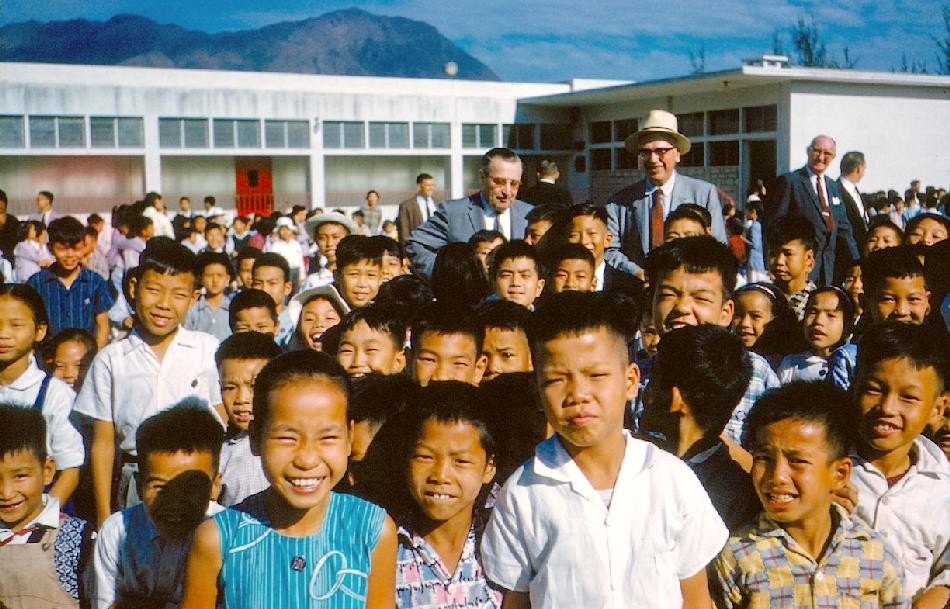
Hong Kong: Refugees

Figure 1.--Hong Kong virtually since its creation has been a haven for Chinese people fleeing natural disasters, war, pestulance, and famine. In modern times it has been a haven for Chinese people fleeing Communism and the terrible disasters that Mao and his associates caused. Pehaps the most serious was hunger and famine. Mao's Great Leap Forward caused the worst famine in human history (1956). And food problems persisted into the 1960s. Most of the refugees had to be turned away from tiny Hing Kong. This 1964 color slide shows Hong Kong Chinese refugee children at a Refugee Center school. The adults are Americans. We are guessing they are from charitable groups aiding with the refugee problem. Unfortuntely, that is all I know about the image.
|
|
As the British presence was established in Hong Kong, the developing center became a have for refugees in tumultous times and famine. The first major influx occurred during the Taipai Rebellion (1850-64). The Civil War and Japanese invasion caused refugees to seek safety in Hong Kong. The Japanese invaded China (1937), but did on seize the Internatiuonal Settlement in Shanghai and the British Hong Kong Crown Colony until over 4 years later (December 1941). With the Communist victory in the Civil War a massive killing program began of land lords, merchants, Nationalist officials and others. Another wave of refugees flowed into Hong Kong (1948). The British had to turn most back. More refugees tried to get into Hong Kong as Mao's policies like the Great Leap Forward created a terrible famine. The Communist victory in the Vietnam War created another wave of people, this time the Vietnamese boat people (1975). Some 144,000 Vietnamese refugees were resettled in third countries. Another 67,000 Vietnamese were deported back to Vietnam to uncertain fates. Only about 1,000 Vietnamese refugees were granted residence in Hong Kong. [Choi] The Chinese refugee problem only ceased when the Mainland Communist Government led by Chairmanf Deng took the starteling step of introducing market reforms (meaning capitalism) (1998). The phenomenal success that resulted meant that decent lives and prosperous circumstances were possible in China itself. A new refugee isue had arisen in recent years--the asylum question.
History
As the British presence was established in Hong Kong, the developing center became a have for refugees in tumultous times and famine. The first major influx occurred during the Taipai Rebellion (1850-64). The Civil War and Japanese invasion caused refugees to seek safety in Hong Kong.
World War II
The Japanese invaded China (1937), but did on seize the Internatiuonal Settlement in Shanghai and the British Hong Kong Crown Colony until over 4 years later (December 1941).
People Republic
With the Communist victory in the Civil War a massive killing program began of land lords, merchants, Nationalist officials and others. Another wave of refugees flowed into Hong Kong (1948). The problem was that Hong Kong was a tiny British Crown Colony along the southern coast near Canton which could accomodate only a fraction of the Chinese peole seeking to flee the abject poverty that came with Communism. They refugees came in waves. The largest wave came with the disaster of Mao's Great Leap Forward which created the most deadly famine in Chinese history. Millions starved. And the only outlet from the uffering was tiny Hong Kong. Vast numbers of mainland refugees fled across the Shenzhen (a small fishing village) border to seek better lives in Hong Kong. As one author tells us, "Neither East Germans climbing the Berlin Wall nor the tens of thousands of North Koreans crossing the Yalu River to the Chinese city of Dandong could compare to the exodus from the mainland to Hong Kong. It’s an epic account of the fate of communists seeking a better life in a capitalist harbour, at a cost of life and blood." [Bingan] Some 2 million people goy into Hong Kong, mostly illeglly. The nu,br of people who dies along the way or were teturned to the Chinese Communists we are unsure.
Vietnamese Boat People
The Communist victory in the Vietnam War created another wave of people, this time the Vietnamese boat people (1975). Some 144,000 Vietnamese refugees were resettled in third countries. Another 67,000 Vietnamese were deported back to Vietnam to uncertain fates. Only about 1,000 Vietnamese refugees were granted residence in Hong Kong. [Choi]
Chinese Market Reforms
The Chinese refugee problem only ceased when the Mainland Communist Government led by Chairmanf Deng took the starteling step of introducing market reforms (meaning capitalism) (1998). The phenomenal success that resulted meant that decent lives and prosperous circumstances were possible in China itself. A new refugee issue had arisen in recent years--the asylum question.
Sources
Bingan, Chen. The Great Exodus to Hong Kong (2013).
Choi, Christy. "Controversy over Hong Kong's asylum seekers harks back to Vietnam," South China Morning Post (May 21, 2014).
CIH

Navigate the Children in History Website:
[Return to Main Hong Kong page]
[Return to Main Chinese refugee page]
[Return to Main Chinese regions page]
[Return to Main Opium War page]
[Return to Main specific 19th century war essay page]
[Return to Main European colonialism page]
[Introduction]
[Animals]
[Biographies]
[Chronology]
[Climatology]
[Clothing]
[Disease and Health]
[Economics]
[Ethnicity]
[Geography]
[History]
[Human Nature]
[Law]
[Nationalism]
[Presidents]
[Religion]
[Royalty]
[Science]
[Social Class]
[Bibliographies]
[Contributions]
[FAQs]
[Glossaries]
[Images]
[Links]
[Registration]
[Tools]
[Children in History Home]
Created: 7:08 PM 11/14/2016
Last updated: 7:53 PM 12/28/2018



